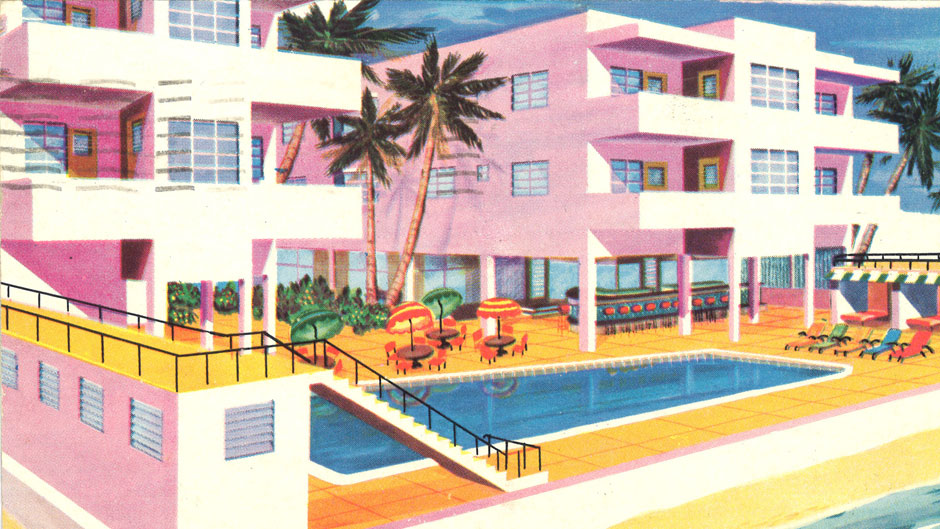Rosie, an Asian elephant, used to march up and down the streets of Miami Beach in the early 1900s. The spectacle was a promotional ploy by then-developer Carl Fisher to draw visitors to the area. It worked.
Photos and drawings of Rosie and many other advertisements of the era are part of the University of Miami Libraries’ Special Collections. On Thursday, department head Cristina Favretto highlighted them in an online seminar called “Selling Some Sand: The Marketing of Miami Beach.” This is the first event in a series called “Deep Dives,” which highlights select fascinating items in the Special Collections.
Using photos, pamphlets, books, and other documents from the collection, Favretto led the participants through the history of the beach, which began after land owner and farmer John Collins and the wealthy entrepreneur Carl Fisher teamed up to build the first bridge from the mainland to the barrier island.
Images of Collins in front of the bridge are part of the collection, as is a book with a drawing of Fisher and his wife alongside the elephant named Rosie.
Fisher, an entrepreneur from Indiana who had become a promoter of the automobile industry, was a born showman, said Favretto. He was determined to make Miami Beach a playground destination for those with the means to travel there.
He spent a lot of money first clearing out the mangroves and dredging soil from the bay, which he then covered with topsoil from the Everglades. He planted tropical flowers, palm trees, and other exotic plants. Fisher believed in the power of advertising. To highlight the fledgling beach resorts, including the Roman Pools and the Flamingo Hotel, which he built, Fisher launched an advertising campaign that included bathing beauties in skimpy bathing suits and people dancing and playing in the sun.
“A lot of the advertisers and the graphic designers they were working with liked to project an image that Miami was a thriving metropolis,” Favretto said.
Several images in the collection showed drawings of sunbathers frolicking in the sun contrasted with those of men shoveling snow up north.
His campaign fueled part of the Florida land boom of the 1920s. Many came to enjoy what Florida had to offer. But sadly, many of the Blacks who worked for the hotels and who had initially helped clear the land for development were excluded from enjoying the beach.
“Miami Beach was welcoming to those who had money and it may have been called a playground but it was a playground as long as those people were white and Gentiles,” said Favretto.
One poignant photo in the collection is that of a young Black woman next to a sign that reads “Virginia Key Beach. Colored Swimming.” Virginia Key Beach was the only beach open to Blacks in Miami.
Slowly, South Beach was developed, and photos from the 1920s begin to show the “modern hotels,” now part of what is known as the Art Deco district. The collection also contains pictures and menus from Wolfie’s and The Rascal House on Collins, delis that were established once restrictions on Jews begin to ease, as well as images of the iconic Fontainebleau Hotel, built by Morris Lapidus.
Photos from the 1960s and 1970s, a period known for celebrity activity on Miami Beach, include singer Frank Sinatra and his rat pack as well as Jackie Gleason, the famous entertainer who was an “indefatigable booster for Miami Beach,” Favretto said. One image shows Gleason in front of the Washington Avenue theatre that was named after him.
“In the 1980s the beach fell into hard times with a growing crime rate that kept many away,” said Favretto. Special Collections holds many magazines from this time, including the now-infamous “Paradise Lost” issue of TIME Magazine.
“Miami Vice,” the television show that helped put Miami Beach back on the map, is also broadly represented, mostly through zines. Short for "fanzines," these are self-published publications on a variety of topics. Special Collections has more than 15,000 of them from all over the world, including hundreds created by the show’s fans.
“There are not too many places in the world where you can have this great confluence of great culture, weather, and fascinating architecture,” said Favretto.
Watch a recording of the event here.
Other events in this series are:
Thursday, October 8 at 1 p.m.
The Liberation of Paris: The G.I. and the Amazon
Presented by Arthur Dunkelman, curator of the Jay I. Kislak Collection
Thursday, October 22 at 1 p.m.
Diving Deep: An Artist’s Book Trip Through the Oceanic Zones
Presented by Jay Sylvestre, Special Collections librarian
Thursday, November 5 at 1 p.m.
Book of Fate
Presented by Chelsea Jacks, Special Collections reference assistant

